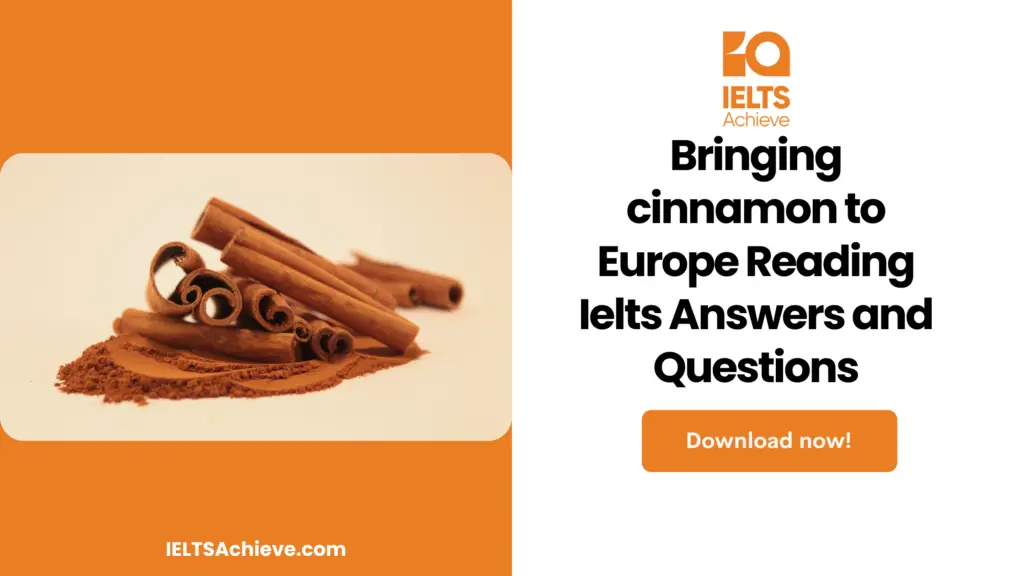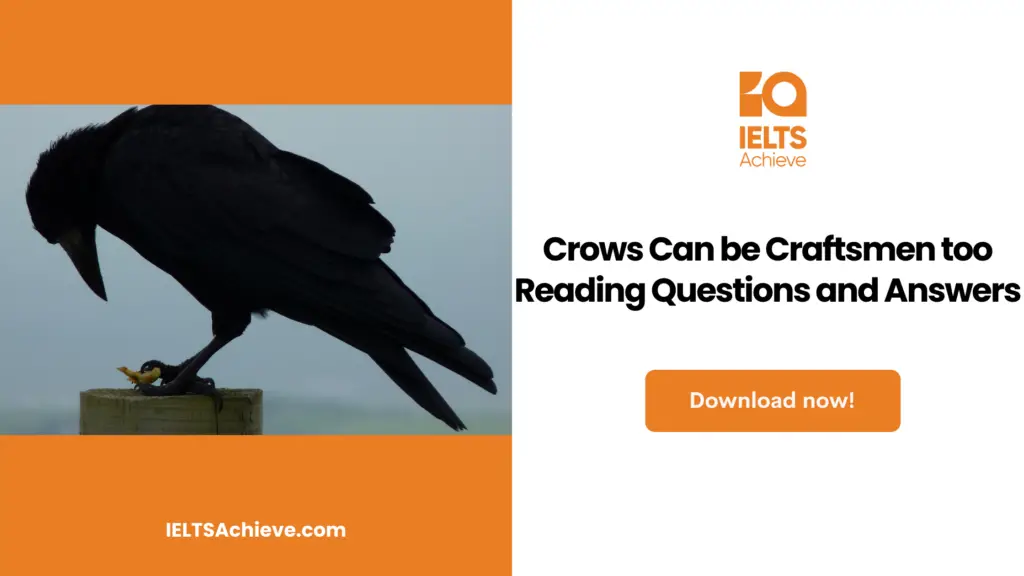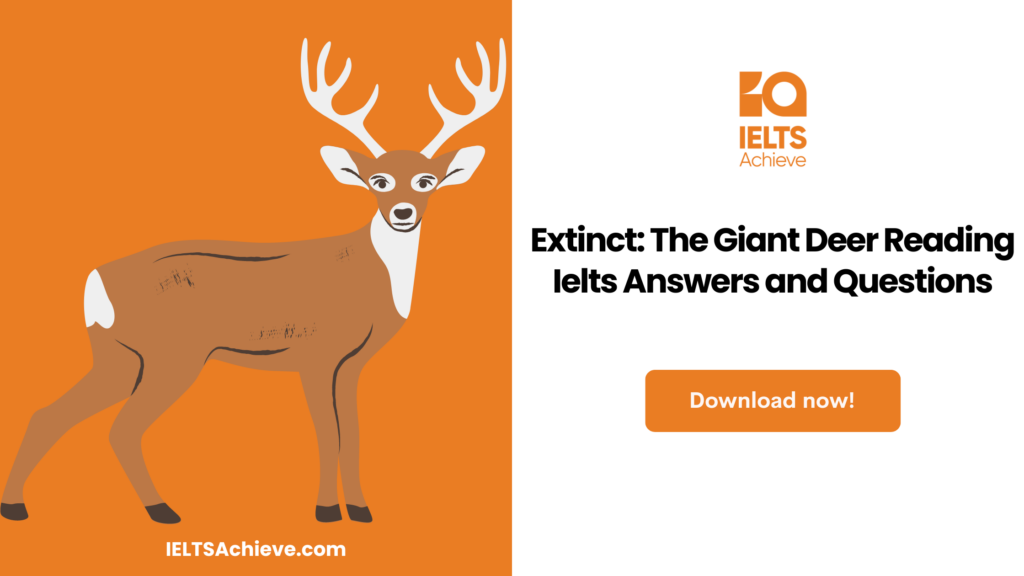The Blog post contains the following IELTS Reading Questions:
- IELTS Reading Matching Headings
- IELTS Reading True/False or Not Given
- IELTS Reading Note Completion

IELTS reading passage – Bringing cinnamon to Europe
Bringing cinnamon to Europe
The inner bark of trees within the genus Cinnamomum, indigenous to the Indian subcontinent, is used to make cinnamon, a sweet, aromatic spice. It was well-known throughout the period of the Bible and is referenced in a number of its books as a component that was combined with oils for application to people’s bodies as well as a token indicating friendship among lovers and friends. For a nice aroma, mourners in ancient Rome who were attending funerals would burn cinnamon. However, the spice was most frequently used as a food and beverage additive. The spice was used in the Middle Ages by Europeans who could afford it to flavor meals, especially meat, and to show off to others their capacity to get an expensive condiment from the “strange” East. A host would provide visitors with a platter during a feast with a variety of spices piled on it as a symbol of the wealth at his or her disposal. Additionally, cinnamon was said to offer health advantages and be able to treat a number of conditions, including indigestion.
At the end of the Middle Ages, the European middle classes started to aspire to the living of the privileged, such as their use of spices. The need for cinnamon and other spices increased as a result. At that time, Arab traders carried cinnamon and kept the location of the spice’s origin a closely-guarded secret from possible competitors. They rode camels through the desert to the Mediterranean from India, where it was cultivated. When they arrived in Alexandria, their trip was over. European merchants sailed there to get their supply of cinnamon, then returned to Venice with it. The spice then made its way from that important commercial port to marketplaces across Europe. Due to Venice’s near monopoly on the trade and the limited availability of the spice due to the overland trade route, the Venetians established a price of cinnamon extravagantly high. These costs and the rising demand encouraged Europeans who wanted to participate in the spice trade to look for new ways to Asia.
Portuguese traders came to Ceylon in the 15th century in the quest for cinnamon riches. Before Europeans arrived, the state produced cinnamon. Salagama members would pull cinnamon bark from fresh trees during the rainy season when it was more flexible. The coiled bark created the spice’s “stick” shape while peeling. Salagama gave the finished object as an homage to the monarch. The Portuguese enslaved many more native Ceylonese to increase cinnamon production. 1518: Portugal builds a fort in Ceylon. This allowed them to secure the island, monopolize cinnamon trading, and generate huge profits. In the 16th century, Ceylon’s cinnamon exports to India yielded a 10-fold profit. Eight days were spent traveling.
The Dutch had the goal of dethroning the Portuguese as the rulers of cinnamon when they first arrived off the southern Asian coast at the start of the 17th century. The interior Ceylonese kingdom of Kandy was linked with the Dutch. They shielded the native ruler from the Portuguese in exchange for gifts of elephants and cinnamon. When the Dutch invaded and took control of the Portuguese industries in 1649, they ended the 150-year Portuguese monopoly. They had successfully driven the Portuguese from the island by 1658, seizing control of the valuable cinnamon trade in the process.
Just like the Portuguese preceding them, the Dutch also mistreated the locals in order to maintain their market dominance. The Dutch started changing the Ceylonese harvesting procedures in order to increase production and feed Europe’s insatiable need for cinnamon. As a result of routine bark-stripping, the island’s stock of cinnamon trees eventually became almost depleted. The Dutch eventually started growing their domestic cinnamon trees to augment the dwindling supply of natural trees.
The Dutch lost their monopoly over cinnamon when the English arrived in Ceylon in 1996. The output of cinnamon increased to 1,000 tonnes annually by the middle of the 19th century as a lower-grade composition of the spice became more palatable to European palates. By then, Brazil, Guyana, the West Indies, and other areas of the Indian Ocean were also growing cinnamon. A monopoly of cinnamon was no longer viable, and the economic potential of the spice trade as a whole was declining. Ultimately, coffee, tea, chocolate, and sugar commerce overtook spices.
Bring back the big cats IELTS reading questions
Questions 1-4
Reading Passage has six sections, A-F. Choose the correct heading for sections A-D from the list of headings below.
Write the correct number, i-v, in boxes 1-4 on your answer sheet.
1. Section A
2. Section B
3. Section C
4. Section D
List of Headings
- A civilized profit-making business
- Introduction of Portuguese traders to Mexicans
- Establishment of cinnamon’s monetary value
- Values of cinnamon other than just a food ingredient
- Occupation of Dutch over Portuguese monopoly
Ready to conquer Matching Headings questions? Click here to learn essential tips and techniques for matching headings accurately to paragraphs or sections in the IELTS Reading section.
Questions 5-8
Do the following statements agree with the information given in Reading Passage 1? In boxes 5-8 on your answer sheet, write
TRUE if the statement agrees with the information
FALSE if the statement contradicts the information
NOT GIVEN if there is no information on this
5. During the 19th century, the spice trade continued to be an economically significant activity.
6. With their arrival in Ceylon, the Dutch supplanted the Portuguese in the cinnamon trade.
7. All through the 16th century, the Portuguese monopolized Ceylon’s cinnamon trade.
8. Compared to the natural trees, the Dutch-planted trees produced more cinnamon.
Enhance your skills in identifying information as True, False, or Not Given. Click here to discover expert strategies and techniques for mastering this question type in the IELTS Reading section.
Questions 9 – 14
Complete the notes below.Choose ONE WORD ONLY from the passage for each answer. Write your answers in boxes 9-14 on your answer sheet.
The Early History of Cinnamon
| Biblical times: added to 9. __________utilized to display 10. __________ Between citizens |
| Ancient Rome: used for its sweet aroma at 11. __________ |
| Middle Ages: added to food, especially meat was a sign of a person’s 12.__________ known as a remedy for 13. __________ and other health issues developed in 14. __________ |
Unlock your full potential in the IELTS Reading section – Visit our IELTS Reading Practice Question Answer page now!
Recommended Questions:
Renewable Energy IELTS Reading Question with Answer
Bringing cinnamon to Europe Reading Answers
1. IV
2. III
3. I
4. V
5. False
6. False
7. True
8. Not Given
9. Oils
10. Friendship
11. Funerals
12. Wealth
13. Indigestion
14. India

We hope you found this post useful in helping you to study for the IELTS Test. If you have any questions please let us know in the comments below or on the Facebook page.
The best way to keep up to date with posts like this is to like us on Facebook, then follow us on Instagram and Pinterest. If you need help preparing for the IELTS Test, join the IELTS Achieve Academy and see how we can assist you to achieve your desired band score. We offer an essay correction service, mock exams and online courses.

